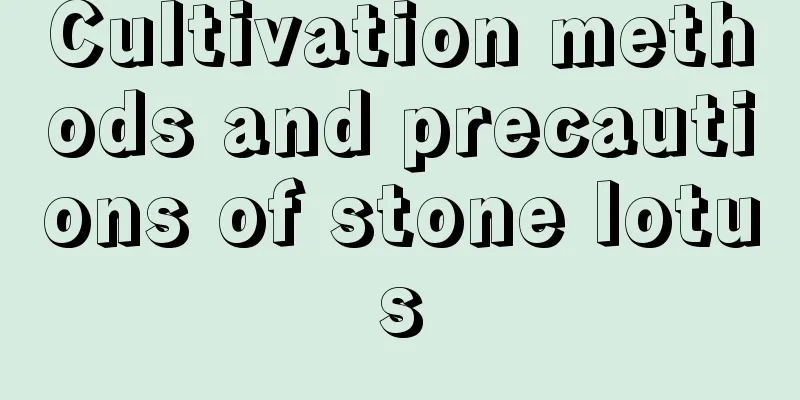Cultivation methods and precautions of stone lotus

1. Maintenance methods1. Soil: Echeveria likes to grow in sandy soil, and also has a certain ability to tolerate barrenness. When raising it at home, you can prepare the soil by mixing leaf mold, river sand and a small amount of garden soil. 2. Light: Echeveria is native to barren areas of the desert and can withstand strong light. When raising it, you need to place it in a location with sufficient light. If the light is too strong in summer, it is still necessary to shade it to prevent its leaves from aging faster. 3. Temperature: Stone lotus can grow in a high temperature environment, but is not resistant to low temperatures. It is best to grow it in an environment of 25 to 30 degrees Celsius. In winter, it needs to be moved indoors for maintenance, and in summer, it can be placed in a ventilated place. 4. Watering: It is extremely drought-resistant, so there is no need to water it on time. It can grow with a small amount of water. But be careful not to water the core of its leaves when watering. 2. Breeding techniques1. Reproduction: The simplest method of reproduction is leaf cuttings. Pick a stronger leaf on the outside and place it on the soil, or insert it into the soil and wait for about ten days. The old leaf will grow fibrous roots and small leaves. 2. Repotting: It is best to repot it when the weather is clear. When taking out the plant, be careful not to tear its roots. After potting, water it thoroughly and place it in diffused light for a period of time and it will return to normal. 3. Problem diagnosis and treatment1. Soft leaves: If only one or two leaves at the bottom become soft, it is a normal metabolic phenomenon. If there are too many, it may be that too much water has been given. The roots need to be taken out to dry and then re-potted. 2. Black weevil: This is one of the main insect pests. Once discovered, it needs to be killed with tweezers as soon as possible. If necessary, it needs to be sprayed with 500 times diluted 25% carbaryl wettable powder. IV. Other issues1. Is it poisonous? Stone lotus is not toxic and does no harm to the human body, so you can rest assured during maintenance. 2. Can it be grown indoors: Echeveria can be grown indoors, but because the glass blocks most of the ultraviolet rays, the growth effect is definitely not as good as direct sunlight. Therefore, in order for it to grow better, it is better to grow it outdoors. |
<<: Miracle fruit cultivation methods and precautions
>>: Crystal Lotus Cultivation Methods and Precautions
Recommend
How to grow a cactus to make it big and round (how to grow a new cactus to make it grow more vigorous)
The cactus plant is not big and is suitable for g...
How to take care of the newly bought fortune tree
1. Temperature In order to reduce the metabolic r...
Is Ji Longyue poisonous?
1. Hazards It is non-toxic, so you can raise it w...
How to cultivate coral palm
1. Soil To grow coral palms, you need to use soil...
How to grow Cattleya
Farming methods temperature The suitable growth t...
What to do if lavender leaves wilt
1. Reasons (1) Temperature In an environment wher...
What to do if hyacinth is pinched by an arrow
1. Reasons 1. Low temperature Hyacinthus generall...
What is lily of the valley and how to propagate it
1. What is Lily of the valley is a perennial herb...
Cucumber high yield fertilization method
In recent years, cucumber cultivation has perform...
What are the benefits of black wolfberry? How to eat black wolfberry
1. Nourish the liver and improve eyesight Black w...
How to prune grape seedlings
Grape seedling pruning time Grape seedlings are u...
How to grow a maidenhair fern in a bottle
Selection of bottles for the maidenhair fern It i...
Key points for grape management in January
Grapes generally prefer warm environments and hav...
How to propagate figs by cuttings, diagram of fig cuttings
1. Cutting 1. Cutting time: The cutting time of f...
When is the best time to sow Podocarpus seeds?
Podocarpus seed sowing time Podocarpus seeds are ...









